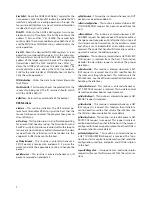
3
Figure 2. CY7C63743-PXC –ADNS-3080 Optical Mouse Hardware Block Diagram.
Serial Peripheral Interface (SPI)
The CY7C63743-PXC provides a SPI compatible interface.
The SPI circuit supports byte serial transfer in either
Master or Slave mode. The integrated SPI circuit allows
the CY7C63743-PXC to communicate with an external
SPI compatible hardware, in this case the ADNS-3080
sensor.
Hardware Implementation
The standard hardware to implement a mouse is shown
in Figure 2. For X and Y movement, the optical mouse
sensor is used. The Z wheel movement is detected by
another set of optical encoder that outputs quadrature
signals. For each button there is a switch that is pulled up
internally by the built-in in pull up resistors. The D-line is
pulled up via a 1.3k ohm resistor connected to the VREG
pin.
Firmware Confi gurable GPIO
The reference fi rmware is confi gured to use the GPIO pins
as shown in the schematic under Appendix A. However, it
may be more optimal to use a diff erent I/O confi guration
to meet the mechanical constraints of PCB design. The
reference fi rmware is designed to be easily confi gured
to another set of pin connections. This is accomplished
through changes in the I/O defi nitions at the beginning
of the adns- 3080.asm listing. The following statements
are the pin defi nitions as they exist today. The fi rmware
will use these defi nitions to read and confi gure the GPIO
pins, without any other modifi cations.
Communications between the CY7C63743-PXC and the
ADNS-3080 are done through the integrated SPI inter-
face. The serial port cannot be activated while the chip
is in power down mode (NPD low) or reset (RESET high).
When the SPI is enabled thru P0.4 (NCS), P0.7 (SCLK),
P0.6 (MISO), and P0.5 (MOSI) GPIO pins serve as special
functions enabling the SPI interface to talk with the ex-
ternal hardware. (Sensor) During normal operation, the
CY7C63743-PXC SPI is always confi gured as a Master to
output the serial clock on P0.7. So, the USB microcon-
troller always initiates communication. Data sent by the
ADNS-3080 optical sensor is received on the P0.6 (MISO),
and data is shifted out to the same sensor through P0.5
(MOSI). See schematic in Appendix A. When writing to
the ADNS-3080, the microcontroller drives both SCLK
and MOSI lines. When reading from the ADNS-3080, the
microcontroller drives both SCLK and MOSI lines initially.
After tSRAD delay, the ADNS-3080 will drive the data via
MISO. The microcontroller is only driving the SCLK line (
for the serial interface).
Avago
ADNS-3080
Optical Mouse Sensor
Wheel Button
Right Button
Z Optics
Cypress
CY7C63743A-PC
enCoRe
USB Controller
USB/PS2 Interface
MISO
MOSI
SCLK
NCS
D+/D-
SCLK/SDATA
VREG
1.3 k Ohm
Left Button
Z LED




































